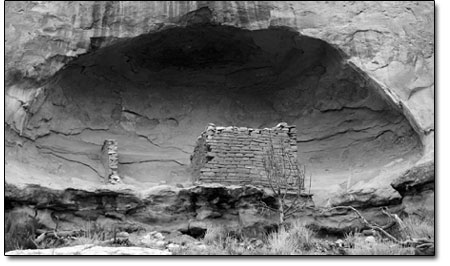|
| ||
| Canyons in crisis SideStory: An endangered monument
by Will Sands "Toxic, carcinogenic pits” could be the newest neighbor to the Canyons of the Ancients National Monument. The local archeological resource may soon share space with a dump for the oil and gas industry if plans for the “Outhouse Recycling Facility” meet with favor. Located 45 miles west of Durango, the Canyons of the Ancients encompasses 164,000 acres and represents the highest density of archeological sites in the country, often containing more than 100 sites per square mile. The large area of high desert was designated a monument by a controversial presidential proclamation in June 2000 but has faced variety of threats since. Prior to and since the proclamation, the land has been put to the test by livestock grazing, off-highway vehicle abuse, pot hunters, and oil and gas drilling.Now the desert just west of Cortez is facing a new challenge. A project ironically named “The Outhouse Recycling Facility” has been proposed near the town of Pleasant View. The facility would sit on a portion of the 474-acre Hovenweep Canyon Ranch, which is bordered on three sides by the national monument. The Outhouse was conceived as a way to “receive, treat and recycle exploration and production materials” from oil and gas drilling in the region, according to the project application. By materials, the applicants are referring to the slurry used in the process of hydraulic fracturing (or “fracing”) – whereby oil companies inject fluid at high pressure below ground to free up additional oil and gas deposits. Some of the objections pertain to the fluid that would be “recycled,” said Jimbo Buickrood, public lands coordinator for San Juan Citizens Alliance. While the exact recipe of fracing fluid is unknown and considered proprietary information, it is known to contain hazardous chemicals. “These are extremely toxic, hazardous and potentially radioactive wastes,” Buickrood said. “There are literally hundreds of chemicals in there, and basically their version of recycling is taking these fluids and putting them in huge evaporative ponds.” As many as 10 four-acre ponds have been proposed with up to 60,000 gallons of oilfield waste being delivered each day. Over its 20-year projected lifespan, the Outhouse Recycling Facility could be home to as much as 104 million gallons of spent fracing fluid. The proposal raises a number of significant concerns, according to Buickrood. The site is just a stone’s throw away from the Painted Hand Pueblo and would be located alongside a national scenic byway en route to Hovenweep National Monument. In addition, any breaches or leaks in the Outhouse would flow downstream into Canyons of the Ancients. “Anything that flows out or leaks from the impoundment goes straight into the monument,” Buickrood said. “Siting hazardous waste pits next to the Canyons of the Ancients, which is an iconic resource, is beyond ridiculous.” Conservationists aren’t the only ones outraged by the proposal for the Outhouse Recycling Facility, which would also be located upwind of many of Montezuma County’s large farms. A coalition of concerned neighbors has taken shape, and Gary Wright, an adjacent farmer, is among them. Wright noted that the project took the Pleasant View community by surprise, and landowners have had a difficult time uncovering just exactly what has been proposed. “It turns out the Outhouse Recycling Facility is just a very low-cost, low-tech method of handling oil and gas drilling byproducts,” he said. “The evaporative pond is really the only technology behind this project.” Like Buickrood, Wright objects to the toxic and hazardous qualities of fracing fluid. He added that once the fluid evaporates those toxins could blow onto his farmland and through his front door. “My main concern is that the predominant winds come up from the Monument Valley to the Southwest, and this project will be directly upwind of many of these farms,” Wright said. “I know for a fact that the salt brine in the fluid will defoliate our crops. But there are also a bunch of other chemicals in that mixture along with a bunch of unknowns.” The Outhouse Recycling Facility’s first day before the Montezuma County Planning Commission sparked a major turnout in late February. Buickrood and Wright expect the opposition to pick up as the project works its way through a major planning pipeline, which should include state and federal reviews. “We understand that there is an oil and gas resource in the region,” Buickrood said. “But we need to do this right. It’s nonsensical to adversely affect our agricultural heritage and tourism economy for an ill-sited, hazardous dump.” One proponent of the project, Casey McClennan, a member of the Montezuma County Planning Commission, opted not to comment for the story. •
|
In this week's issue...
- May 15, 2025
- End of the trail
Despite tariff pause, Colorado bike company can’t hang on through supply chain chaos
- May 8, 2025
- Shared pain
Dismal trend highlights need to cut usage in Upper Basin, too
- April 24, 2025
- A tale of two bills
Nuclear gets all the hype, but optimizing infrastructure will have bigger impact


